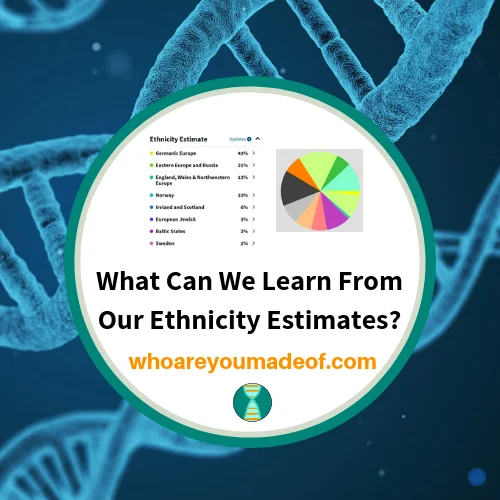Ethnicity estimates are easy to print out, summarize, and share - what's not to love about them? We know they are popular and sought after, but what can we learn from our ethnicity estimates?
One of the most popular aspects of DNA testing is the ethnicity estimate, which is also referred to as "ancestry composition" or an "ancestry estimate". While occasionally controversial, it's easy to understand why this aspect of DNA testing is appealing.

Ethnicity estimates get a lot of unfair criticism from the media and are dismissed by people who are "serious" about DNA and genealogy as being only good for entertainment purposes. I've been working with DNA and genealogy for many years, have tested my DNA and that of my family members with several different companies.
In this post, I would like to share with you what I have learned we can discover from our ethnicity estimates.
Our ethnicity estimates can teach us about DNA inheritance
One of the most first things that we can learn from our ethnicity estimates is how DNA inheritance works. By understanding how DNA is passed down through the generations, we will understand more about our family tree and what our ethnicity estimate can tell us.
I decided to start this post off with this because it's important to understand that our ethnicity estimates don't provide information to us about ALL of our ancestors. Instead, our ethnicity estimates can help us learn about some of our ancestors - the ones from whom we inherited DNA.
In order to understand why, we need to learn a little bit about DNA inheritance.
Every person inherited 50% of their DNA from their mother an 50% from their father. They only inherit 50% of each of their parent's DNA, which means that each of their parents have about 50% of their DNA that they didn't pass down to each of their children.
This happens every generation again and again and again. After several generations, it's possible to share very little (or even zero) DNA with an ancestor.
While it's true that we will share DNA with all of our recent ancestors, we will share only small amounts, or even none, with our more distant ancestors. This is really important when it comes to ethnicity estimates and understanding what they might be able to tell us about our family history.
Additionally, the 50% of a person's DNA that gets passed down to the next generation is "randomly selected" through a process called recombination, so there is no way to know whether we'll get all of our parent's Italian DNA, some of it.
An ethnicity estimate can tell us which regions of the world most closely match our DNA, but they can only show results using the DNA that we have and can't teach us anything about the DNA that never got passed down to us.
Learning about recombination helps us understand that, especially when our parents only have a small amount of DNA matching a particular region, it's perfectly possible to inherit none of that DNA.
We can learn where our family probably lived over the past 300 years
Our ethnicity results can help us understand where our family probably lived over the past 300 years and where some of our ancestors lived going back much further than that, perhaps as far as a few thousand years in some cases.
The chance that we would have inherited no DNA from a particular ancestor increases with distance from the ancestor due to recombination. For example, it's theoretically possible to have inherited no DNA from a great-great-great grandparent, though extremely unlikely (about a .01% chance).
Going back three more generations to a great-great-great-great-great-great grandparent, however, the chance of having no detectable relationship increases to 17.76%.
How our ethnicity estimates can be accurate for telling us about our recent family history
Because it is almost impossible to have inherited no DNA from an ancestor that is related to us at a 4th great-grandparent distance or closer (there is only a .56% chance of sharing no DNA with a 4th great-grandparent), there is a good chance that we share at least some DNA with all of our ancestors at this distance.
All 64 of my 4th great-grandparents were born about 200 years ago; how far back your 4th great-grandparents were born might vary.
Even though I share at least some DNA with all 64 of my 4th great-grandparents, there is no way to know what their ancestry composition report would have looked like (unless I'm lucky and can do an artifact DNA test).
This means that the DNA that they did pass down to me might not be what I really expect it to be. I'm lucky to know who any of my great-great-great-great-grandparents are, and I'd be exceptionally lucky to know who their great-great-great-great grandparents were.
Why our ethnicity estimate can't tell us more about our distant ancestors
Most of my 6th great-grandparents (my great-great-great-great-great-great-grandparents) were born between 1740-1760, which is 268 years ago. I probably inherited at least some DNA from many of my 256 ancestors that far back.
Going back three more generations to my 9th great-grandparents, however, there is a 73.50% chance of having no shared DNA that could be detected. My 9th great-grandparents were born in the 1650s, about 360 years ago.
It's important to note that the amount of DNA that I might have inherited from any of these very distant ancestors would be very small.
As you can see, the further back in our tree we go, the less likely we will have inherited any detectable DNA from a given ancestor. In order for a particular ethnicity region to show up on our ethnicity estimate, or ancestry composition report, we will need to have inherited DNA from an ancestor who had that region in their DNA and passed it down through each generation - "surviving" recombination - to us.
How our ethnicity estimates can possibly go back a thousand years or more
Some of the information on our ethnicity estimate could be from ancestors 1,000 years back, or even more.
Even though it's highly unlikely to have inherited DNA from any particular very distant ancestor - say, one going back 20-30 generations or so - it doesn't mean that we didn't inherit DNA from any of them.
The big chunks of DNA that we inherit directly from our parents is made up of smaller pieces of DNA that was inherited from their ancestors - and it is safe to assume that some of those smaller pieces of DNA have been passed down for many, many generations.
The chances of inheriting a DNA segment large enough to be detectable on an ethnicity estimate decreases dramatically due to distance from the common ancestor. We also know that recombination is random and there is no way to be sure that no DNA segments can slip intact through the generations and arrive in your DNA.
This is why our ethnicity estimates might have some traces of our ancestors ethnicity going back many hundreds of years. Of course, it is more reliable for our more recent ancestry.
Do you want to do a DNA test?
If you haven't already done a DNA test, you might be interested in checking out my post titled, "Beginner's Guide to DNA Testing: Ultimate Strategy" where I explain the best way to choose a test (hint: it depends on what type of information you want to learn from DNA testing) and my strategy for saving money on your DNA test.
Conclusion
I hope that this post has given you some ideas about what you might be able to learn from your ethnicity estimate. Whether or not you've already done a test or you are thinking about doing one, I'm sure you found some information in this post that is helpful to you.
If you have any questions about something that you read here, or you would like to share your experience with ethnicity estimates, I would love to hear from you in the discussion below.
Thanks for stopping by today!


